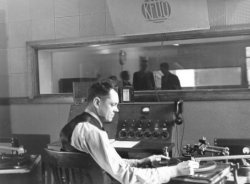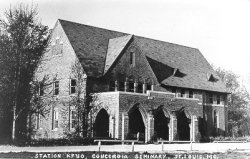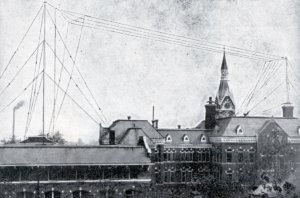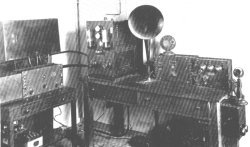Radio Articles
KFUO Was One Of St. Louis’ First Stations
Although it has jumped up and down the radio dial during its 73 years of broadcasting, KFUO is still owned by the same organization that put the station on the air back in 1924.

The Lutheran Church Missouri Synod’s seminary board proposed development of the station at its meeting in February of 1923, and a broadcasting license was issued October 25, 1924.
When KFUO went on the air Dec. 14 of that year, the first broadcast originated from the attic of one of the seminary buildings. It shared the 550 kHz frequency with KSD, which was owned by the St. Louis Post-Dispatch, and the religious station broadcast two programs per week initially. Its founders say KFUO is the oldest religious radio station in the world. By 1928, the number of hours of broadcasting had increased to 21 per week.
In 1927, in a move that reflected the chaos encountered by the federal government in its attempts to regulate the radio industry, KFUO was forced into a time share with KFVE at 1280 kHz (KFVE later became KWK), but a month later the time share with KSD was reinstated. By 1933, KSD determined it wanted the 550 spot all to itself and set out to find a new frequency for the Lutheran station.

In 1936, application was made, but legal wrangling by government agencies prevented the change from taking place for 7 years. On July 1, 1940, KFUO, with 1,000 watts of power, was assigned to 830 kHz. A year later the station was moved to its present “home” at 850 kHz, and power was increased to 5,000 watts the following September.

The station’s studio was originally located at the old Concordia Seminary on South Jefferson in St. Louis, and it followed the move of the seminary to its present grounds in Clayton in 1926. The station now shares studios with KFUO-FM, which went on the air in 1948.
At one point in 1935, the Lutheran Church turned down an offer of $100,000 for the station from the St. Louis Star-Times. (Publisher Elzey Roberts then bought KFRU in Columbia, Mo., and ended up building KXOK in St. Louis within a year.) Although KFUO is on a commercial frequency, it does not run advertisements, instead relying on monetary donations from its listeners. As for any hidden meanings in the call letters, a reference was found in printed material that read “Keep Forward-Upward-Onward!”
(Reprinted with permission of the St.Louis Journalism Review. Originally published 7/97)


